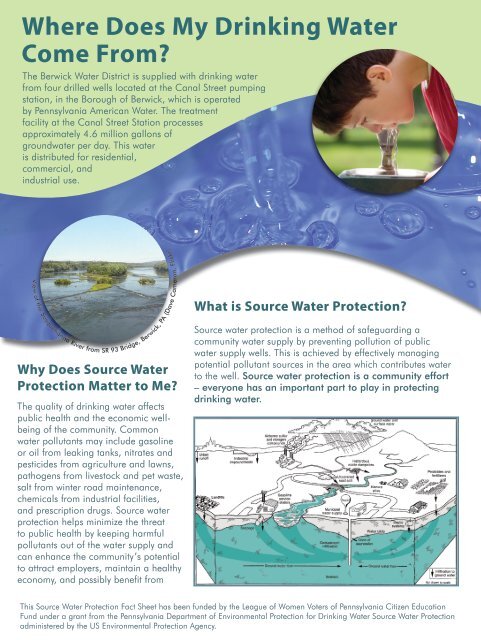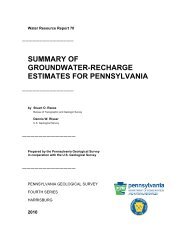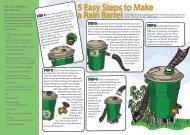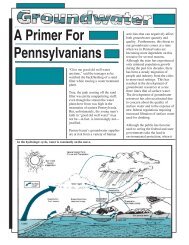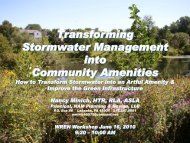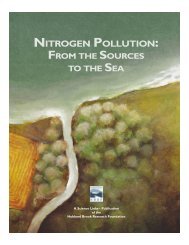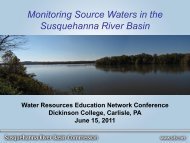Where Does My Drinking Water Come From? - League of Women ...
Where Does My Drinking Water Come From? - League of Women ...
Where Does My Drinking Water Come From? - League of Women ...
- No tags were found...
Create successful ePaper yourself
Turn your PDF publications into a flip-book with our unique Google optimized e-Paper software.
<strong>Where</strong> <strong>Does</strong> <strong>My</strong> <strong>Drinking</strong> <strong>Water</strong><br />
<strong>Come</strong> <strong>From</strong><br />
The Berwick <strong>Water</strong> District is supplied with drinking water<br />
from four drilled wells located at the Canal Street pumping<br />
station, in the Borough <strong>of</strong> Berwick, which is operated<br />
by Pennsylvania American <strong>Water</strong>. The treatment<br />
facility at the Canal Street Station processes<br />
approximately 4.6 million gallons <strong>of</strong><br />
groundwater per day. This water<br />
is distributed for residential,<br />
commercial, and<br />
industrial use.<br />
View <strong>of</strong> the Susquehanna River from SR 93 Bridge, Berwick, PA (Dave Cameron, Flickr)<br />
What is Source <strong>Water</strong> Protection<br />
Why <strong>Does</strong> Source <strong>Water</strong><br />
Protection Matter to Me<br />
The quality <strong>of</strong> drinking water affects<br />
public health and the economic wellbeing<br />
<strong>of</strong> the community. Common<br />
water pollutants may include gasoline<br />
or oil from leaking tanks, nitrates and<br />
pesticides from agriculture and lawns,<br />
pathogens from livestock and pet waste,<br />
salt from winter road maintenance,<br />
chemicals from industrial facilities,<br />
and prescription drugs. Source water<br />
protection helps minimize the threat<br />
to public health by keeping harmful<br />
pollutants out <strong>of</strong> the water supply and<br />
can enhance the community’s potential<br />
to attract employers, maintain a healthy<br />
economy, and possibly benefit from<br />
Source water protection is a method <strong>of</strong> safeguarding a<br />
community water supply by preventing pollution <strong>of</strong> public<br />
water supply wells. This is achieved by effectively managing<br />
potential pollutant sources in the area which contributes water<br />
to the well. Source water protection is a community effort<br />
– everyone has an important part to play in protecting<br />
drinking water.<br />
This Source <strong>Water</strong> Protection Fact Sheet has been funded by the <strong>League</strong> <strong>of</strong> <strong>Women</strong> Voters <strong>of</strong> Pennsylvania Citizen Education<br />
Fund under a grant from the Pennsylvania Department <strong>of</strong> Environmental Protection for <strong>Drinking</strong> <strong>Water</strong> Source <strong>Water</strong> Protection<br />
administered by the US Environmental Protection Agency.
Once a <strong>Water</strong> Supply Source Becomes Contaminated<br />
6Clean 6 up can take years and may not be possible<br />
6Clean 6 up is costly<br />
6Required 6 treatment adds to the operating costs <strong>of</strong> the water treatment plant, causing rates to increase<br />
6Developing 6 a new source for water supply is expensive<br />
The expense <strong>of</strong> treating polluted water or finding a new source <strong>of</strong> drinking water can be avoided through<br />
source water protection.<br />
What Can You Do<br />
6Limit 6 the use <strong>of</strong> fertilizers, pesticides and<br />
herbicides on your lawn and garden.<br />
6Recognize 6 and manage possible sources<br />
<strong>of</strong> pollution on your property.<br />
6If 6 you have a septic system, make sure it<br />
is properly maintained.<br />
6Have 6 heating oil tanks checked regularly<br />
for leaks.<br />
6Conserve 6 water.<br />
6Dispose 6 <strong>of</strong> used motor oil at a garage<br />
that will recycle it. Never pour oil down the drain, in a storm drain or sewer, or on the ground.<br />
6Use 6 hazardous products – such as paint, varnishes and other chemicals – as directed and take them to<br />
a county waste collection site for disposal.<br />
Ways to Get Involved<br />
6Participate 6 in clean-up activities in your neighborhood.<br />
6Help 6 identify potential sources <strong>of</strong> pollution in your source water protection area.<br />
6Help 6 educate your neighbors and others about source water protection.<br />
For More Information<br />
On Source <strong>Water</strong> Protection: http://water.epa.gov/drink/index.cfm<br />
On <strong>Water</strong> Conservation: http://www.epa.gov/watersense/our_water/be_the_change.html ,and<br />
http://www.amwater.com/paaw/learning-center/wise-water-use.html<br />
On Septic System maintenance: http://www.epa.gov/npdes/pubs/homeowner_guide_long.pdf<br />
Typical activities around the home can affect groundwater quality: http://dnr.wi.gov/org/water/dwg/gw/pubs/SmartGrowth3.pdf<br />
and the Columbia County Conservation District


